Neal Auction Company, New Orleans, Louisiana
Southern Furniture and High Museum Deaccessions Star at $2.9 Million Auction
by Lita Solis-Cohen
Southern furniture from local estates and 19th-century furniture and decorative glass deaccessioned from the High Museum in Atlanta, Georgia, brought a good local crowd and some bidders from afar to Neal Auction Company in New Orleans on February 18-20. The 1385 lots, most of them pictured in color in the catalog, brought a total of a little more than $2.9 million, including the 20% buyer’s premium on the first $50,000 and 10% on any amount over $50,000. (For purchases made by cash, check, or wire transfer, Neal deducts 2.5% from the 20%.)
Stephen Harrison, curator of decorative arts at the High Museum, said he chose Neal to auction the museum’s deaccessions because the market for 19th-century material is strong in New Orleans. He was not disappointed. Some strong prices were paid for material no longer needed in Atlanta, and only a handful of lots was passed.
After careful review, over a period of three and one half years, the High Museum decided to sell duplicates and other objects the curators deemed unnecessary to make a point in the gallery installations. Harrison said the late Virginia Carroll Crawford, who funded the purchase of American decorative arts of 1825-1917, knew the collection would be refined over the years, and she was well aware of the culling process and the sound reasoning behind deaccessioning.
The collection was put together in the 1980’s by consulting curator David Hanks and the late High Museum curator Donald Peirce. In 1999 the High Museum published an illustrated hardback catalog, Art & Enterprise: American Decorative Art, 1825-1917, The Virginia Carroll Crawford Collection by Donald Peirce, documenting every piece in the Crawford collection and putting them in context.
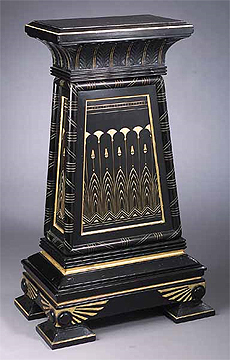 In the Neal auction catalog, the page number and plate number in Art & Enterprise were given for the three dozen Crawford collection lots offered so bidders could go to that catalog and learn more about them. For example, according to the entry in Art & Enterprise (page 145, plate 74), the ebonized cherrywood pedestal in the Egyptian taste made in New York circa 1875 has moldings and carving seen on the temple façade at the Centennial Exposition’s Egyptian Court, and its incised gilt decoration may have been inspired by the designs of English reform designer Owen Jones’s 1856 influential book The Grammar of Ornament, a fact not mentioned in the sale catalog. In the Neal auction catalog, the page number and plate number in Art & Enterprise were given for the three dozen Crawford collection lots offered so bidders could go to that catalog and learn more about them. For example, according to the entry in Art & Enterprise (page 145, plate 74), the ebonized cherrywood pedestal in the Egyptian taste made in New York circa 1875 has moldings and carving seen on the temple façade at the Centennial Exposition’s Egyptian Court, and its incised gilt decoration may have been inspired by the designs of English reform designer Owen Jones’s 1856 influential book The Grammar of Ornament, a fact not mentioned in the sale catalog.
"The pedestal is one of a pair, and not a pendant," Harrison said in a phone interview before the sale. "Two identical pedestals are not necessary for display." The pedestal was estimated at $2000/3000 and sold for $58,750 to Baltimore dealer Milly McGehee in the salesroom bidding for a client. The underbidder was on the phone.
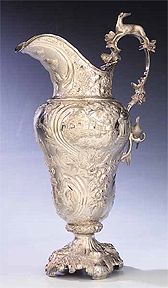 The High Museum also kept one of a pair of silver pitchers made by Samuel Kirk in Baltimore circa 1845; the two are illustrated on page 74, plate 37, in Art & Enterprise. Harrison said the museum did not need two of them. The pitcher, 16¾" high, chased with vignettes of birds, flowers, and architecture and with the unidentified initials GEA, sold for $16,450 (est. $3000/5000) to another institution. The High Museum also kept one of a pair of silver pitchers made by Samuel Kirk in Baltimore circa 1845; the two are illustrated on page 74, plate 37, in Art & Enterprise. Harrison said the museum did not need two of them. The pitcher, 16¾" high, chased with vignettes of birds, flowers, and architecture and with the unidentified initials GEA, sold for $16,450 (est. $3000/5000) to another institution. 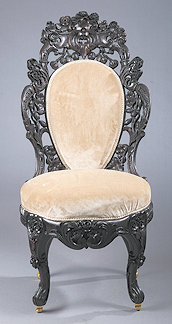 The pair (one shown) of rosewood Rococo Revival side chairs, 1855-60, attributed to John Henry Belter, New York City, came from a huge suite that included tables and other chairs, of which four chairs and a sofa were in the Crawford collection. "We can only display the sofa and two chairs; space in the museum is at a premium," said Harrison. The pair deaccessioned sold for $30,550 (est. $15,000/20,000). The other three pieces from the suite are on display in the museum. The pair (one shown) of rosewood Rococo Revival side chairs, 1855-60, attributed to John Henry Belter, New York City, came from a huge suite that included tables and other chairs, of which four chairs and a sofa were in the Crawford collection. "We can only display the sofa and two chairs; space in the museum is at a premium," said Harrison. The pair deaccessioned sold for $30,550 (est. $15,000/20,000). The other three pieces from the suite are on display in the museum.
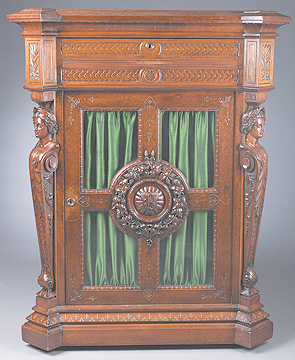 The Neo-Grec walnut cabinet with caryatids at its corners, attributed to Daniel Pabst, Philadelphia, is similar to one at the Philadelphia Museum of Art that has been attributed to Pabst since the 1930’s. The "B" in the center of a wreath on the door stands for Borie. The Bories, a Philadelphia family, were Pabst customers. Estimated at $10,000/15,000, it sold for $17,625 to a San Francisco collector. The Neo-Grec walnut cabinet with caryatids at its corners, attributed to Daniel Pabst, Philadelphia, is similar to one at the Philadelphia Museum of Art that has been attributed to Pabst since the 1930’s. The "B" in the center of a wreath on the door stands for Borie. The Bories, a Philadelphia family, were Pabst customers. Estimated at $10,000/15,000, it sold for $17,625 to a San Francisco collector.
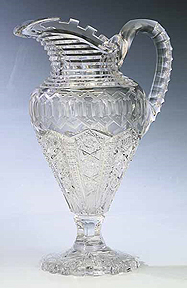 Cut glass from the High Museum brought far more than estimated. The Brilliant cut glass pitcher in the Alhambra pattern, made by the Meriden Cut Glass Company in Connecticut, was not illustrated in the catalog but was illustrated on page 291, plate 168, in Art & Enterprise. Estimated at $1000/1500, it sold for $14,100. Cut glass from the High Museum brought far more than estimated. The Brilliant cut glass pitcher in the Alhambra pattern, made by the Meriden Cut Glass Company in Connecticut, was not illustrated in the catalog but was illustrated on page 291, plate 168, in Art & Enterprise. Estimated at $1000/1500, it sold for $14,100.
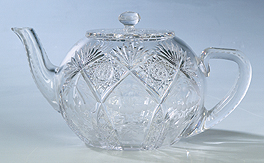 The H.P. Sinclaire & Company cut glass teapot, made in Corning, New York, circa 1917, brought $5287.50 (est. $500/700); a Brilliant cut glass punch bowl on stand by Pitkin and Brooks, Chicago, 1900, sold for $6462.50 (est. $1200/1800); and a jug and two glass tumblers made by Libbey Glass Company, Toledo, Ohio, circa 1896, fetched $7050 (est. $500/700). All were illustrated and discussed in Art & Enterprise. The H.P. Sinclaire & Company cut glass teapot, made in Corning, New York, circa 1917, brought $5287.50 (est. $500/700); a Brilliant cut glass punch bowl on stand by Pitkin and Brooks, Chicago, 1900, sold for $6462.50 (est. $1200/1800); and a jug and two glass tumblers made by Libbey Glass Company, Toledo, Ohio, circa 1896, fetched $7050 (est. $500/700). All were illustrated and discussed in Art & Enterprise.
Several lots of art pottery from the High Museum found buyers. An Aesthetic art pottery vase attributed to Maria Longworth Nichols, founder of the Rookwood pottery in Cincinnati, sold for $4993.75 (est. $4000/6000). A yellow Van Briggle vase with high shoulders and modeled flower buds sold for $2350. A pair of Neo-Grec porcelain vases, probably Paris, fetched $1997.50 (est. $2000/3000). All are recorded in Art & Enterprise.
Harrison knows what he is going to do with his newfound money. "I’m closing in on a large figural stained-glass window by John La Farge that honors Mrs. Crawford’s desire to have this important American artist represented in the collection," he said after the sale.
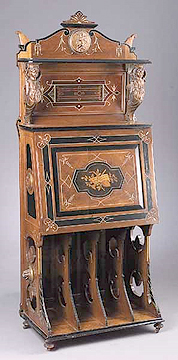 Most but not all of the deaccessions were from the Crawford collection. The Neo-Grec walnut music cabinet with gilt and ebonized decoration made in New York, 1865-70, that sold for $5405 (est. $1500/2500) was donated by Priscilla Weldon St. Germain of Lafayette, Louisiana, in memory of her grandparents, who lived in Atlanta. It relates to a cabinet in the Lockwood-Matthews Mansion in Norwalk, Connecticut. In a letter to the editor of M.A.D. (March 2005, page 4-A), St. Germain wrote that she was disappointed that her piece was not included in any museum catalogs and that she was not told in advance of the museum’s decision to sell it. Most but not all of the deaccessions were from the Crawford collection. The Neo-Grec walnut music cabinet with gilt and ebonized decoration made in New York, 1865-70, that sold for $5405 (est. $1500/2500) was donated by Priscilla Weldon St. Germain of Lafayette, Louisiana, in memory of her grandparents, who lived in Atlanta. It relates to a cabinet in the Lockwood-Matthews Mansion in Norwalk, Connecticut. In a letter to the editor of M.A.D. (March 2005, page 4-A), St. Germain wrote that she was disappointed that her piece was not included in any museum catalogs and that she was not told in advance of the museum’s decision to sell it.
Harrison said that any money realized from the sale of any piece in the collection goes toward acquiring something else and that the credit lines are then transferred to any new object purchased with the proceeds from the sale of deaccessions.
Neal Auction Company, the oldest auction house in New Orleans, holds cataloged sales every two months in its gallery on Magazine Street, tucked between the Garden District and the uptown neighborhood. Southern regional painting, Newcomb College pottery, New Orleans silver, and furniture of the South have been its specialty for the last 16 years. Neal Alford, the founder of the company, has six women in key positions on his staff. Katherine Hovas, the vice president, came to the firm in 1995 with ten years of experience in estate administration and a J.D. degree from the University of Mississippi. The specialists and catalogers have degrees in art history and certificates from appraisal programs, and they recognize regional southern furniture that may be overlooked elsewhere in the country. A group of collectors of Louisiana furniture compete at their sales.
 John Cummings, a New Orleans attorney who is restoring Whitney Plantation in order to tell the story of the slaves in Louisiana, ferrets out local material at Neal sales. He bought a southern inlaid cherrywood sideboard, circa 1800, made in Natchez, Mississippi, for $102,750, more than five times its high estimate. "The plantation house on Whitney Plantation was built by a German in 1790, more than a dozen years before the Louisiana Purchase," said Cummings, explaining why the circa 1800 sideboard was appropriate for the house. John Cummings, a New Orleans attorney who is restoring Whitney Plantation in order to tell the story of the slaves in Louisiana, ferrets out local material at Neal sales. He bought a southern inlaid cherrywood sideboard, circa 1800, made in Natchez, Mississippi, for $102,750, more than five times its high estimate. "The plantation house on Whitney Plantation was built by a German in 1790, more than a dozen years before the Louisiana Purchase," said Cummings, explaining why the circa 1800 sideboard was appropriate for the house.
Cummings also bought several pieces of furniture made in Louisiana to be used in the house or its outbuildings. He paid $15,275 (even though it has a restored cornice) for a Louisiana painted cypress armoire, 1790-1800, found in Saint Landry Parish with original lamp black paint. Then for $2820 he bought a Louisiana cypress worktable with a three-board top and a drawer (est. $2500/3500). He paid $14,100 for an early 19th-century Louisiana cypress blanket chest with hand-forged carrying handles made out of 30" boards from the virgin forest (est. $4000/6000). The Colonial West Indian rosewood and marquetry commode (est. $5000/8000) cost him $11,750.
"After the slave uprising in Haiti, planters fled to New Orleans with their slaves and planted sugar cane," he said, explaining why the commode will help him tell the story of plantation life. "I will have sugar cane growing on Whitney Plantation to tell that story," he said.
Cummings paid $5581.25 for a huge (6'7" diameter x 34" high) cast-iron sugar kettle with a flared rim. He had to go to $4230 to buy the English pottery abolitionist spill vase with a transfer print of a kneeling slave in shackles It was estimated at $400/600 because it had a hairline crack. He battled a phone bidder from New Jersey who collects ceramics with painted or transfer decoration relating to slavery and abolition.
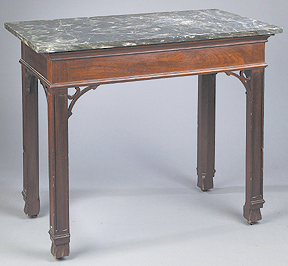 Cummings did not bid on the mahogany marble-top sideboard table in the plain style of the early South, made in Virginia, 1760-75. It has cherry as the secondary wood, guttae feet, and paneled legs similar to legs of the kettle stand made at the Anthony Hay shop in Williamsburg, Virginia, now at Winterthur. Sumpter Priddy III, who wrote the catalog entry, does not think the marble-top table is from that Williamsburg shop, but he does think it was made in tidewater Virginia, and the marble top is original. It sold for $124,750 to a collector on the phone. Cummings did not bid on the mahogany marble-top sideboard table in the plain style of the early South, made in Virginia, 1760-75. It has cherry as the secondary wood, guttae feet, and paneled legs similar to legs of the kettle stand made at the Anthony Hay shop in Williamsburg, Virginia, now at Winterthur. Sumpter Priddy III, who wrote the catalog entry, does not think the marble-top table is from that Williamsburg shop, but he does think it was made in tidewater Virginia, and the marble top is original. It sold for $124,750 to a collector on the phone.
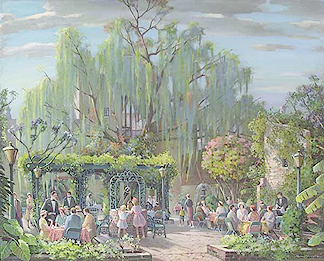 Several paintings by local artists brought more than expected. Patio of the Court of Two Sisters Restaurant by Clarence Millet (1895-1959) sold for $58,750 (est. $20,000/30,000), demonstrating that regional interest extends to paintings as well as furniture. Several paintings by local artists brought more than expected. Patio of the Court of Two Sisters Restaurant by Clarence Millet (1895-1959) sold for $58,750 (est. $20,000/30,000), demonstrating that regional interest extends to paintings as well as furniture.
Rooster and Chicks, a watercolor by Walter Inglis Anderson, a Mississippi artist, painted 1940-45, sold for $30,550 (est. $25,000/35,000). It pays to sell pictures close to where they were painted.
Also of local interest, a Newcomb College embroidered linen lamp mat, 1908-12, 16" x 15", with a multicolored band of blossoms and foliage sold for $1837.50 (est. $2500/3500). A program to create embroidered objects was begun at Newcomb College in 1902 by Gertrude Roberts Smith using the same standards of design established for pottery.
Some Centennial furniture brought strong prices. A Philadelphia armchair, cataloged as in the style of William Savery with a yoke-shaped crest rail and a carved splat, knuckle arms, and cabriole legs with ball-and-claw feet sold for $11,456.25. A pair of matching side chairs fetched $7343.75. An accompanying photograph of an 1884 painting by Isaac L. Williams documents the chairs in use in the boardroom of the Historical Society of Pennsylvania after HSP moved to new quarters at 1300 Locust Street in 1884. The catalog notes that well-known New Orleans antiquarian Felix Herwig Kuntz purchased the chairs from HSP in 1948. Kuntz (1890-1971), dean of Americana collectors in New Orleans, made a major gift from his collections to the New Orleans Museum of Art.
Copyright, Maine Antiques Digest, May 2005 |